Healthy You
Your guide to living well





Healthy You is an award-winning magazine featuring health and wellness articles and promoting practical tools that support and encourage healthier choices.
This educational resource for UMR members is published four times a year as part of our member online services and can be viewed, downloaded and shared digitally.
Healthy You is packed with helpful resources and practical recommendations to address the most common health topics, including:
• Building healthy habits
• Preventive care recommendations
• Chronic health conditions
• Exercise tips
• Nutrition and recipes
• Stress and mental health management
• First aid and getting care
• Health literacy
• Spanish-language resources
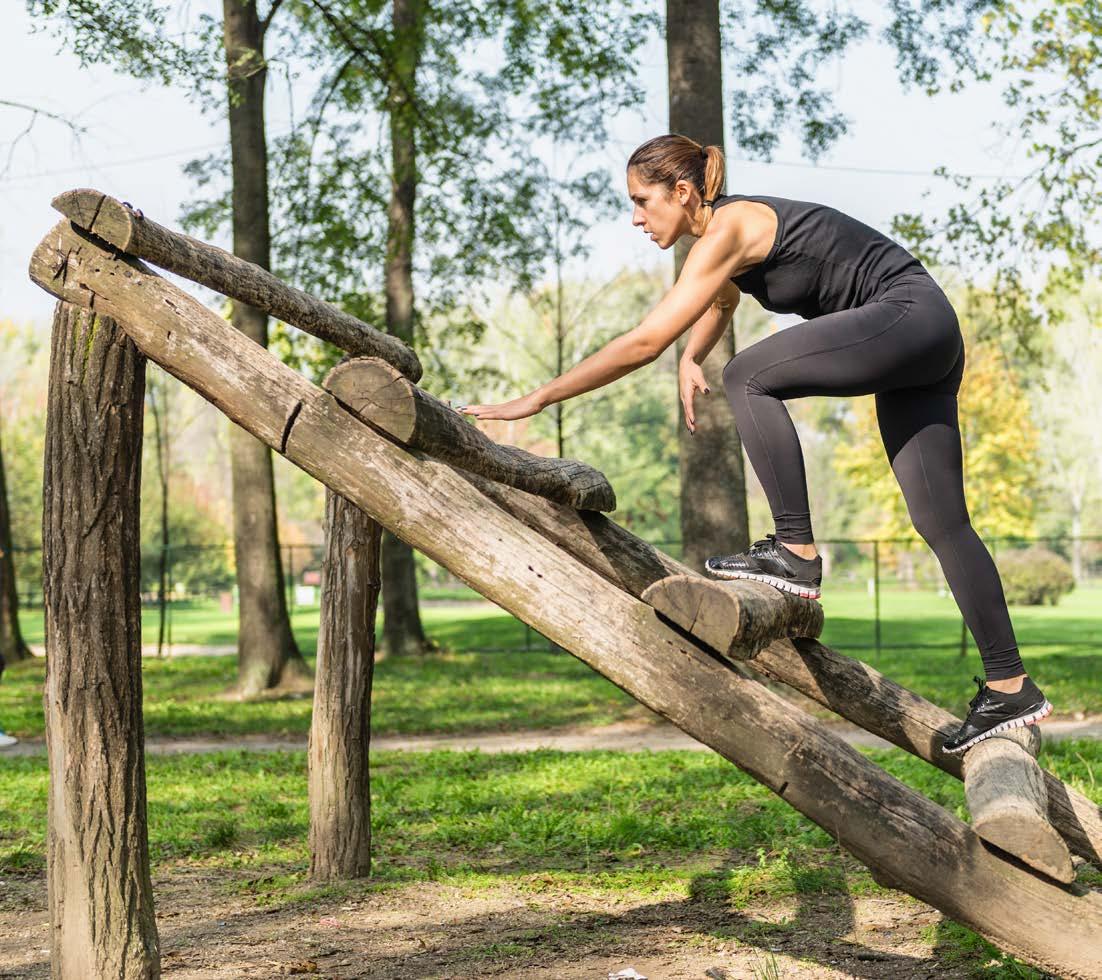
While using this electronic publication, you may click on a link to other websites. We provide links to other websites that may contain information that may be useful or interesting to you. We do not endorse, and are not responsible for, the content and accuracy of linked websites operated by third parties or for any of your dealings with such third parties. You are solely responsible for your dealings with such third parties, and we encourage you to read the terms of use and privacy policies on such third-party websites.
Available features and benefits are dependent on the products and features included in the plan design. Not all members will have access to all features shown.
Copyright © 2025 United HealthCare Services, Inc.
Reproduction in whole or part is not permitted without permission in writing from UMR. All information and links were accurate and functional at the time of publication. However, because this electronic publication contains links to third-party sites, information can change and become unavailable.

Track all your claims in one place

Check in at your convenience to see if a claim has been processed and what you might owe. You can search the claim activity for everyone on your plan, view your claims cost summary or submit a new claim.
Check out this FREE resource.
Sign in to your member account on umr.com.
Welcome to a smarter, simpler, faster way to manage your health care benefits, right from the palm of your hand.


The UMR app has a smart fresh look, simple navigation and faster access to your health care benefits information. View your plan details on demand — anytime, anywhere.
With a single tap, you can:
• Access your digital ID card
• See a personalized list of your things to do to stay on top of your health and keep your benefits up to date
• Look up in-network health care providers
• Find out if there’s a copay for your upcoming appointment
• View your recent medical and dental claims
• Chat, call or message UMR’s member support team

Download the UMR app today!
Simply scan the QR code or visit your app store to get started.

Make every adventure the best it can be with these 8 simple packing hacks to help you stay healthy, even when surprises arise — and they always do. Let’s unpack each one.
Bring a travel-size first aid kit wherever you go. It’s an easy way to have the supplies you need just in case, like assorted bandages, ointment, wipes, gauze, a mask and more.
If you’re flying, pack medications — prescriptions and over-the-counter items like pain medication — in a carry-on bag. That way, you’ll have what you need, even if your luggage takes a detour.
Whether you’re venturing to a hot or cold climate, remember to stay hydrated. Traveling by air? Bring an empty reusable bottle to fill with water after you get through security at the airport and refill it throughout your trip. Traveling by car? Pack enough reusable water bottles for everyone, and if there’s space, bring a large jug to refill as needed.
Always bring sunscreen and apply it to your skin throughout the day to help protect against UV rays, no matter the climate or weather conditions. Remember to check the expiration date before packing in case you need to pick up a new container.
When traveling, remember to focus on your mental health. Pack a few small items that bring you comfort and joy, like a book and deck of cards, to help pass the time during unexpected delays.
By bringing your smartphone and other tech, you’re just a call or tap away from local resources, quick answers and emergency assistance. Pack extra charging cords, portable charging packs and, for international trips, a plug adapter for outlets in other countries.
Sometimes when traveling, there may be a long time between meals. Pack small snacks to help curb hunger. For those with food allergies or dietary restrictions, packing small amounts of foods you can eat can help you feel your best.
As the saying goes, there’s no bad weather, only bad clothing choices. Weather can change quickly, no matter where you’re headed. To help you avoid feeling too hot or cold, pack clothing that can be layered easily.
For ease, follow the 5-4-3-2-1 method: 5 tops / 4 bottoms / 3 accessories / 2 shoes / 1 swimsuit
Spring is a great time to focus on nutrition. Starting a home garden can be a rewarding way to save money, get exercise and enjoy a mental health boost.
Whether you have a large garden plot, a small patio or just a few pots, you can grow your own herbs and vegetables. Here’s how to get started and some tips to make your gardening journey successful.

Enjoying home-grown food is more than just a tasty pastime. There’s so much more to gain, physically, mentally and even financially.
Growing your own food may reduce your grocery bills. Not having to buy 2-3 items weekly can add up!
Gardening activities like digging, planting and weeding provide a good workout.
Spending time outdoors and nurturing plants can reduce stress and improve your mood.
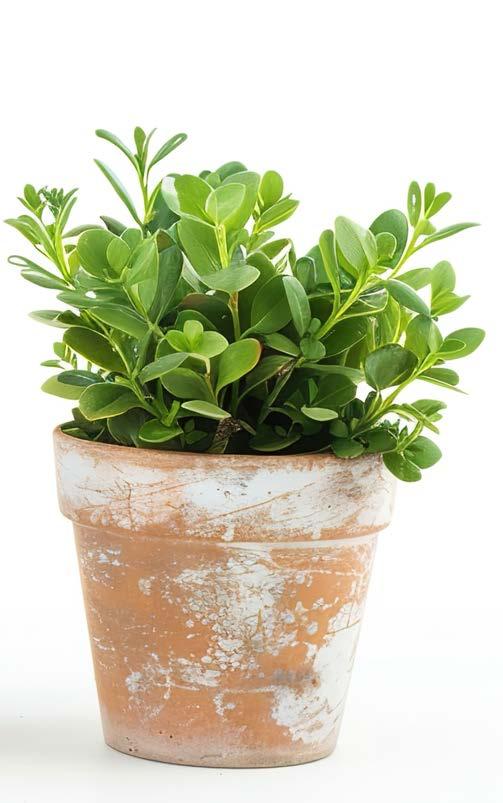
Having direct access to fresh, organic produce can motivate you to start adding more color to your plate.
The best time to plant is usually right before spring, after the last frost. As long as the temperature is warm enough and your plants have access to water, soil and light, you can start gardening at any time.
No matter where you live, there’s a way to garden that’s right for you. Short on space? You have lots of options:
• Planters and pots
Perfect for countertops, patios or balconies. Just make sure containers have drainage holes — plants don’t like soggy soil!
• Vertical gardens
Great for small spaces, such as apartment patios. Use a trellis for climbing plants or place some pots on a shelf.
• Hydroponic planters
Super low-maintenance and can fit on countertops or small tables. Larger, vertical ones are also great for small outdoor areas.
• Community gardens
If you don’t have a lot of space at home, consider joining a community garden. This can also be a great way to connect with others in your area.
You don’t need to be an expert to start growing your own food! Here are some easy-to-grow herbs and vegetables:

• What to know: Low maintenance (doesn’t need much water) and thrives in warm climates
• Where to plant: Prefers direct sunlight and can be sown directly in the ground
• Health benefits: Rich in antioxidants and has anti-inflammatory properties
• How to use: Add fresh to grilled veggies or use dried in pasta sauces and vinaigrettes
• What to know: Resilient and versatile, thrives in full sunlight but tolerates shade
• Where to plant: Can be grown indoors or outdoors but flourishes with lots of sun
• Health benefits: High in vitamin K and may help with sore throats
• How to use: Use as a garnish in drinks, bake into bread or add to creamy sauces
Some plants can be toxic to pets, particularly cats. Research which plants are safe, and keep harmful ones out of reach if you have animals.


• What to know: Grows best in moist soil with partial sunlight and spreads quickly

• Where to plant: Consider planting in a container to control its spread
• Health benefits: Soothes digestion and may ease respiratory issues
• How to use: Perfect for teas, smoothies, cocktails and ice cream
This Earth Day (April 22), getting your hands dirty by growing your own food is a perfect way to celebrate. Planting a garden is a fun way to help the environment and reduce your carbon footprint.
Let your lawn grow wild for the month. This helps bees and butterflies by providing them with more nectar and pollen. Skipping the mower also encourages native plants to thrive.
• What to know: Needs plenty of water and sunlight
• Where to plant: Best grown in garden beds or large containers
• Health benefits: Hydrating and rich in vitamins K and C
• How to use: Slice for salads and sandwiches or dip in hummus for a snack


Requires lots of direct sunlight
Ideal for garden beds or large
High in antioxidants and a great source of vitamins C and K
Add fresh to salads, sauces and salsas


What to know: Easy to grow and prefers cooler weather
Where to plant: Can be grown in garden beds or containers
Health benefits: Low in calories while high in vitamins A and K
How to use: Use fresh in salads and sandwiches
Did you know our skin is our largest organ? Yet most of us don’t think to look in plain sight for signs of skin cancer, which 1 in 5 Americans will develop by age 70.

Is it “just” a mole or more serious?
Generally, any spots on your skin that persist for two weeks or more should be discussed with your doctor.
Skin cancer is the most common type of cancer in the U.S., and anyone can develop it.
Simply put, skin cancer is a disease where the cells in the skin grow out of control. The most common cause of skin cancer is overexposure to ultraviolet (UV) rays from the sun, tanning beds and even sun lamps.
Some people are at higher risk of developing skin cancer than others. According to the Centers for Disease Control and Prevention (CDC), those most at risk include people with these characteristics:
• A lighter natural skin color
• Sk in that burns, freckles or reddens easily or becomes painful in the sun
• Blue or green eyes
• Blond or red hair
• Certain types and a large number of moles
• A history of sunburns or tanning
• A family history of skin cancer
• A personal history of skin cancer
• Aging and thinning hair
Follow this self-exam checklist >
1. Use a full-length mirror to examine the FRONT of your body:
Whole body front and back
Right and left sides, with your arms raised
Face
Ears
Neck Chest
Underarm areas
Women will need to lift their breasts to check the skin underneath
Both sides of your arms
Stomach
The tops and palms of your hands
Between your fingers
Under your fingernails
The front of your legs
2. Use a hand mirror to examine the BACK of your body:
Your scalp — part your hair for a closer look
The backs of your ears
The back of your neck
Lower and upper back
Buttocks Genitals
The backs of your thighs, first checking one leg and then the other
The tops of your feet
Between your toes
Under your toenails
The bottoms of your feet
1. The epidermis: the upper or outer layer
2. The dermis: the lower or inner layer
Skin cancer begins in the epidermis, which is made up of 3 kinds of cells:
• Squamous cells: thin, flat cells that make up the top layer of the epidermis
• Basal cells: round cells that are below the squamous cells
• Melanocytes: found in the lower part of the epidermis and give your skin its color
You’ve probably heard of melanin. It’s the pigment that gives your skin its color. When your skin is exposed to UV light, the melanocyte cells produce more pigment that causes your skin to darken — which results in sunburn and suntan.
Overexposure to UV light will damage skin cells over time, leading to changes in the skin’s texture, permanent skin aging and, sometimes, skin cancer.
Hypodermis
Carcinoma — is a type of cancer that forms in your epithelial tissue — that’s the tissue that lines your skin, organs and internal passageways of the body. Basal and squamous cell carcinomas are the 2 most common types of skin cancer. They develop in the basal and squamous layers of the skin.
• Squamous cell carcinoma — tends to develop on skin frequently exposed to sun, but it can also affect skin not exposed to the sun, especially in people with darker skin tones. This generally appears as a firm red nodule, a scaly or crusty lesion with odd-shaped borders, or a painful or itchy skin lesion.
• Basal cell carcinoma — usually appears on areas with high sun exposure, such as the hands, neck, arms, legs and face. Signs may be pearly or waxy bumps on the skin, a flat, rough or scar-like patch on the skin, or a sore that won’t fully heal.
Melanoma is the third most common type of skin cancer. This type causes the most deaths from skin cancer because it tends to spread to other parts of the body, like vital organs, the brain and the liver.
People with darker skin tones may develop this, especially on their palms or the soles of their feet.
Signs include: the change in a mole’s appearance, a large brown spot, usually with irregular edges or dark lesions on the mucous membranes (such as the nose, mouth, anus or vagina) or the fingers and toes.
Skin cancer will begin as a change in your skin. It could be a sore that won’t heal, a new growth on your skin surface or a change in a mole. Take note of any changes like these, and keep in mind the ABCDEs of melanoma.
They are:
Asymmetrical: Does the mole or spot have an irregular shape with two parts that look very different?


Border: Is the border irregular or jagged?

Color: Is the color uneven?



Diameter: Is the mole or spot larger than the size of a pea?


Evolving: Has the mole or spot changed during the past few weeks or months?


UV rays from the sun can reach you on cool, cloudy days as easily as they can on sunny days. UV rays reflect off surfaces such as water, cement, sand and snow.
It’s important to protect your skin from the sun’s UV rays during all 4 seasons. We all know the importance of using sunscreen during the summer months, but your skin is at risk of damage from the sun during other seasons, as well.
Sunscreen, a wide-brimmed hat, sunglasses and protective clothing should be at the top of your list when you’re spending an hour or more in the sun.
You should also avoid artificial UV light from sources such as tanning beds and sun lamps.
If you have concerns about areas of your skin developing any abnormalities like the ones covered here, make sure to talk to your doctor soon so that adequate screening can be planned.
Some health plans cover a yearly skin cancer screening with a dermatologist at no cost to you. Check your plan for coverage and details.
If you or a loved one has recently undergone cancer treatment, a cancer survivorship care plan can help you feel more in control.

A cancer survivorship care plan is a document that records information about your cancer experience and your current health in one place. If you or your provider needs details about your cancer history, you know just where to find them. And if your cancer returns, you and your provider can easily access information that could help in planning your future treatment. A cancer survivorship care plan may include information about:
• Your diagnosis
• The names of your health care providers and the facilities where you received treatment
• Results of all your cancer tests and treatments
• Information on any clinical trials you took part in
• Types and dates of provider visits you’ll have
• Follow-up screenings and tests you’ll need
• Recommendations for genetic counseling, if needed
• Symptoms or side effects you’ve had since your cancer treatment ended and what to expect
• Ways to care for yourself, such as diet, exercise habits, counseling or stopping smoking
• Information about your legal rights as a cancer survivor
• The risks of recurrence and symptoms to watch for in case your cancer returns
• Ask your doctor for a care plan
• Go online for care plan templates
• Keep your plan up to date; record new tests, new symptoms and additional medications
• Bring your cancer survivorship care plan to all provider visits
MONTHLY HEALTH OBSERVANCES FOR SPRING
APRIL
Alcohol awareness
Distracted driving
Organ donation
MAY
Asthma and allergies
Skin cancer
Mental health
JUNE
Cancer survivors
Men’s health
Personal safety
Finding a network provider on umr.com or the UMR app has never been easier

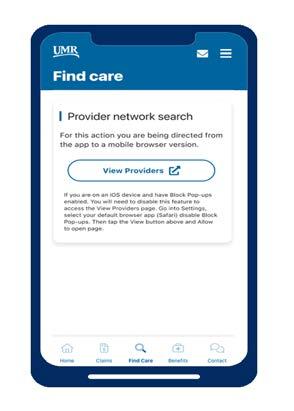
Go to umr.com and select Find a provider
Look for the name of your provider network on your ID card
Don’t have your ID card handy?
That’s OK. If you sign in to umr.com or the UMR app, you will be directed to your in-network provider listing.
Begin a search for your provider network using our alphabet navigation, or type the name into the Search box
It’s common to use over-the-counter (OTC) medications for symptom relief when you’re fighting allergy, asthma or cold symptoms. But what do you do when you either can’t take these medications or you’re still constantly blowing your nose? There are many non-medication options to choose from that can help you feel better and get back to your normal routine.

Some circumstances, such as chronic conditions, certain medicines, age or pregnancy can prevent people from using common OTCs for symptom relief. If you’re not certain whether you should take OTC products, ask your doctor — proactively seeking this information will help the next time hay fever or the cold season hits. And always check with your doctor before stopping any prescription medications.



Can’t use decongestants or your stuffy nose is too severe? Use a saline nasal rinse, spray or drops. A saline nasal rinse, or saltwater rinse, is used with a nasal irrigation device, such as a neti pot, to pour water through your nasal passages to unclog your sinuses. When using this type of device, make sure you follow its instructions and rinse with distilled, sterile or previously boiled water instead of tap water. Tap water isn’t adequately filtered or treated to keep unsafe organisms out of your nose. While your stomach acid kills them, they can thrive in your nasal passages. For young children, it’s best to use a rubber suction bulb to clear mucus.
Try these remedies to alleviate a sore throat or coughing fit:
• Gargle with saltwater — mix 1/4 to 1/2 teaspoon of table salt with 4-8 ounces of warm water.
• Suck on hard candy or cough drops.
• Drink warm liquids.
• Eat something cold, like an ice pop.
• Humidify the air — use a humidifier, sit in a steamy bathroom or breathe in steam from a bowl of hot water.
• Avoid irritants, such as cigarette smoke and cleaning products.





Mix 1 cup of warm distilled or sterile water with 1/2 teaspoon of salt and a pinch of baking soda.

Stay hydrated. Remaining hydrated helps loosen or thin mucus. Not only will this help your stuffy nose, but it can also help with mucus drainage at the back of your nose and throat (post-nasal drip). Try drinking warm liquids, like lemon water or tea with honey, to soothe your throat and relieve congestion.
If allergies are affecting your eyes, try resting with a cool compress over your eyes. The compress can be as simple as a lint-free, clean cloth that has been soaked in water and wrung out before use.
Also, you can clean your eyelids gently with a mixture of baby shampoo and water. Or use lubricating eye drops/artificial tears without preservatives.
While you can’t cure a cold, plenty of rest is important to help your body heal.
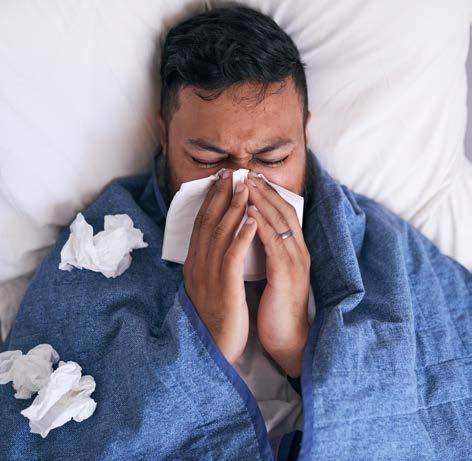

The triggers of asthma and seasonal allergies can vary from person to person. You may find relief by:
• Check ing pollen forecasts to limit your time outdoors during high levels or wearing a pollen mask
• Dusting often with a damp cloth
• Ensuring your pets stay off furniture and out of bedrooms
• Keeping your windows and doors shut when pollen counts are high
• Limiting carpeting, especially where you sleep
• Reducing moisture in the home to prevent mold
• Removing your clothes and taking a shower to rinse off any allergens after outdoor activities
• Using high-efficiency particle air (HEPA) filters in your home, including on forced-air heating or air conditioning units
• Using a dehumidifier or humidifier to keep indoor air at 30-50% humidity
According to the CDC
About 26% of adults and 19% of children under the age of 18 experience seasonal allergies.
Nearly 9% of adults and almost 7% of children under the age of 18 have asthma.
• Using air conditioning in your car and home
• Using allergy-proof covers for pillows, mattresses, etc.
• Using hot water to wash sheets, blankets and stuffed toys once a week
• Using indoor-approved insecticide designed to kill dust mites and other pests
• Vacuuming with a HEPA filter every week
Take a look at the Centers for Disease Control and Prevention’s Home Characteristics and Asthma Triggers resource for more information on reducing asthma triggers commonly found in homes.
Tips for overcoming loneliness in a post-pandemic



A recent Healthy Minds Monthly Poll from the American Psychiatric Association (APA) found:
30% of adults said they had experienced feelings of loneliness at least once a week over the past year. And 10% said they are lonely every day.
Younger adults aged 18-34 were more likely to experience these feelings — 30% said they were lonely every day or several times a week.
Single adults were nearly twice as likely as married adults to say they have been lonely weekly over the past year (39% vs. 22%).


In a world that is so connected, why do we feel so disconnected?



Since the pandemic, many now work remotely and no longer have the social connection that a workplace once provided. Sitting and talking with coworkers has been replaced by emailing and instant messaging.
2. Dependence on technology
Technology has made it easier to connect with people all over the world, yet many are feeling more isolated than ever. It’s easy to spend a night scrolling through social media and commenting rather than going out and doing something.
During the pandemic, many had food delivered instead of going out to a restaurant. That trend has continued today. Plus, fewer people are going to bars and clubs than before the pandemic, decreasing opportunities to interact with others.
Some places of worship have switched to onlineonly services. And shopping online has almost replaced going to the store or the mall.
5.
Many people are more comfortable texting or messaging online than talking to someone in person. And they’re less likely to start a conversation with a stranger in public. As a result, many have fewer social skills than they previously did.


According to a 2021 American Perspectives Survey, 30 years ago, a majority of men (55%) reported having at least 6 close friends. Today, that number has been cut in half. And 15% of men reported having no close friendships at all, a fivefold increase since 1990.
Also, men are less likely than women to admit feelings of loneliness and reach out for help. And many men were raised to “tough it out” when they’re struggling and to “figure things out” by themselves. Changes in social expectations have contributed to all genders — but especially men — feeling apprehensive about pursuing relationships in person. For instance:
• People are often wary or distrusting of a man who is a stranger initiating a conversation with them.
• Men are more afraid to approach women in public — and possibly have their interactions recorded and posted on social media.
• Dating norms have changed from meeting in public to using dating apps, and many men find it difficult to make connections with others online.
• Both men and women are unsure of the social norms in the workplace and are more restrained in their interactions or avoid interacting at all.
All of these shifts have taken a toll on both our social lives and our mental health. The impact includes increased risks of:
• Depression, anxiety and self-harm
• Hear t disease and stroke
• Dementia and Alzheimer’s disease
• Obesity


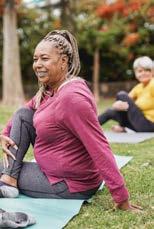
The first step in rebuilding social bonds and improving your mental health is finding new ways to connect. Try these ideas:
Download the Meetup app
It provides a way to connect with people in your community who have similar interests. If everyone has something in common, it’s easier to start a meaningful conversation. And because it’s group focused, it facilitates more than just one-on-one interactions.
Volunteer for a cause you believe in
It’s a way to connect with people who share a similar goal or value.
Join an exercise class or club
If you exercise with others, you are bettering both your physical and mental health and creating the chance to meet new people.
Organize a group outing with your coworkers
Even if you have never met in person before, you can set a time to meet and do a fun activity with people you’re already linked to.
“Loneliness is far more than just a bad feeling — it harms both individual and societal health.”
Surgeon General Vivek Murthy


It may seem difficult to interact with others in real life now that so much of our lives are online. There are some tactics to help strengthen your social skills, though:
• Make eye contact when speaking to others instead of staring down at your phone.
• Start a conversation with a friendly greeting, as simple as “Hello.”
• Be respectful of the other person’s boundaries. If they are uninterested in talking with you, leave them alone.
• Ask people questions about themselves, as this is a good conversation starter.
• If you see someone filming with their phone in public and you don’t wish to be on the Internet, avoid those individuals.

Remember: Other people are feeling lonely and craving real-world connection, too.




Always consult with a health care provider to ensure your exercise plan is safe and effective for your specific condition.
Exercising outside in warm weather is a great way to get fit while getting some sun, vitamin D and fresh air. Outdoor activities not only strengthen your body, but can also lift your mood and reduce stress. Here are a few outdoor exercises you can try to support your fitness and add some fun to your routine!
Before you try these outdoor exercises, it’s important to dress for the warmer weather to stay comfortable, cool and safe.
• Choose light-colored shorts and tank tops made of moisture-wicking material to stay cool, help keep sweat away and prevent irritation during longer workouts.
• Protect your skin by applying sunscreen, and consider wearing a headband or athletic hat to catch sweat and reduce sun exposure.
Hiking provides a wide range of health benefits while allowing you to enjoy nature.

• I t can reduce the risk of heart disease by improving circulation and strengthening your heart — helping you meet the recommended 150 minutes of moderate-intensity exercise each week.
• I t helps to lower blood pressure.
• I t helps control blood sugar levels.
• I t helps enhance balance and mobility, especially for those with arthritis.
To make the most of your hiking experience, you should:
Familiarize yourself with the trail map, check the weather forecast and always let someone know your plans.
Stay hydrated
Bring plenty of water to avoid dehydration, especially on longer trails.
Wear comfortable, supportive shoes, keep your feet dry and use aerosol deodorants or antiperspirants to reduce sweat.



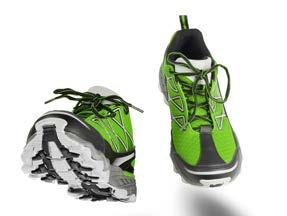

Joining a walking or running club offers all of these physical benefits and more. These clubs provide social interaction, creating a welcoming and inclusive environment where you can make new friends and build connections. Many people find it therapeutic to share experiences and bond with others during walks or runs.
To find a walking or running club near you, try searching in social media groups or the Meetup app.
Walking or running outdoors is a fantastic way to boost your physical and mental health. These activities can help you maintain a healthy weight, lose body fat and prevent or manage conditions like heart disease, stroke, high blood pressure and diabetes. They can also improve cardiovascular fitness, increase energy levels and enhance your mood, cognition, memory and sleep quality. Plus, walking and running strengthen balance and coordination while reducing stress and tension, making them excellent all-around exercises.
If you’re new to walking or running outdoors, follow these tips to stay safe:
• Choose your course carefully: Pick well-lit and safe routes with even surfaces.
• Warm up and cool down: Ease into your workout and stretch afterward to avoid injury.
• Stay prepared: Wear supportive footwear, and bring water to stay hydrated.
Outdoor yoga is a great way to connect with yourself and nature while enhancing your physical and mental well-being. It strengthens your balance, as uneven terrain challenges you to engage your core and focus on stability. It also provides unique health benefits — doing yoga barefoot allows your muscles and joints to stretch while physically connecting with the earth, which can relieve stress, improve sleep and reduce body pain.
To make the most of your outdoor yoga practice, you should:
• Choose the right spot:
Find a local outdoor yoga class or set up your mat in a quiet park or backyard for a peaceful experience.
• Dress appropriately:
Wear breathable clothing that allows for easy movement and comfort.
• Bring the essentials:
Use a thicker yoga mat for cushioning on uneven surfaces, and consider sunscreen, bug spray and a water bottle to stay protected and hydrated.
Golf and pickleball offer fun ways to stay active while building skills and connecting with others. Golf improves focus, coordination and cardiovascular health, while pickleball enhances agility, reflexes and social interaction.

Spring is the perfect time to step outside and explore new ways to stay active. Whether you’re hiking through scenic trails, practicing goat yoga in the park or joining a walking club, these activities offer countless physical and mental health benefits. Trying one or more of these workouts can add variety to your routine and keep your fitness journey fresh, fun and engaging.


Your health care manager at your fingertips
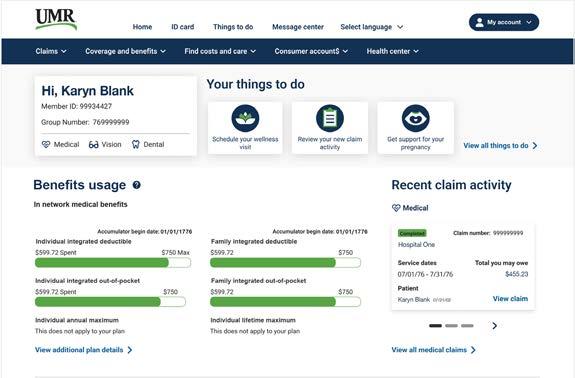
• Review and complete health actions
• Provide/verify your email address
• Provide other insurance information
• Update security questions
• Review new claims
Sign in to umr.com to see a personalized to-do list that highlights the steps YOU need to take to stay on top of your health and keep your benefits up to date. Personalization is based on your company’s health benefits plan and the programs you are eligible for. Visit umr.com today to take advantage of this time-saving feature! Your things to do may prompt you to:
• Be promptly alerted to any denied claims
• Provide accident details
• Go paperless
• Get to know UMR
• Take your clinical health risk assessment (CHRA)
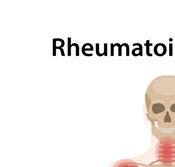


Arthritis is a disease that affects more than 50 million people across the United States. It causes pain, stiffness and swelling in the joints. Staying active can be challenging with arthritis. However, regular exercise is important for managing symptoms and maintaining overall health.
Arthritis can be divided into two types: Rheumatoid arthritis
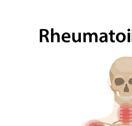

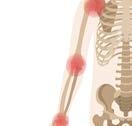







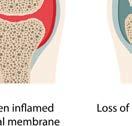
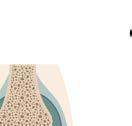


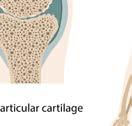
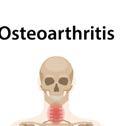


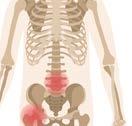




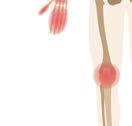
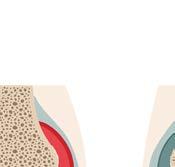




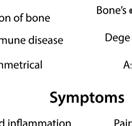






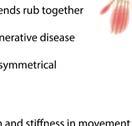


















Rheumatoid arthritis happens when the body’s immune system wrongly attacks its heumatoid arthritis (RA): inflammation that affects many joints, often found in hands and feet.




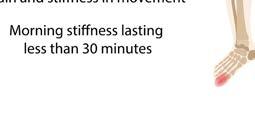
P A type of arthritis linked to psoriasis that causes joint pain, stiffness and swelling.


Osteoarthritis is the most common type of arthritis. It happens when a joint’s cartilage (the smooth coating on the end of bones) breaks down. Over time, the cartilage can slowly deteriorate and cause bone grinding. This causes pain and limited movement. It includes:






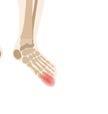

eoarthritis (OA): The most common form of arthritis, often affecting the knees, hips and hands.

• Post-traumatic arthritis: This type can sometimes develop after an injury to the joint — such as a car accident or fall.
Swollen inflamed synovial membrane

Erosion of bone
Symetrical pain, stiffness and inflammation
Autoimmune disease
Morning stiffness lasting more than 30 minutes
Staying active is essential for managing arthritis, but it’s important to choose exercises that are good for your body and your particular type of arthritis. Here are some options:
Regular stretching helps maintain flexibility and range of motion. Focus on gentle stretches for all major muscle groups, holding each stretch for 15-30 seconds.
This low-impact exercise can be easily adjusted to any fitness level. Walking helps improve blood circulation and joint mobility.
Being in water relieves stress on the joints while providing natural resistance to build strength. Swimming and water aerobics are great for cardiovascular health and those with arthritis.
Pilates focuses on core strength, flexibility and overall body awareness. It involves controlled movements that can be modified to suit different fitness levels while being gentle on the joints.
Yoga combines gentle stretching with strength-building poses. It can help improve flexibility, balance and overall well-being. Look for classes specifically designed for people with arthritis.
Whether using a stationary or regular bike, cycling is a low-impact way to improve cardiovascular health and leg strength without putting too much strain on the joints.
This ancient Chinese practice involves slow, flowing movements that improve balance, flexibility and strength. Tai Chi is particularly helpful for reducing stress and improving joint function.

Bones’ ends rub together
Morning stiffness lasting less than 30 minutes
Before starting any new exercise plan, talk to a health care provider you trust — especially if you have arthritis. They can help tailor an exercise plan to your specific needs and monitor your progress. Seek medical advice if you experience:
• Increased joint pain or swelling
• Severe fatigue
• New or worsening symptoms
• Limited range of motion
Early diagnosis and treatment are essential in controlling arthritis, and can significantly improve quality of life. Some benefits include:
• Better management of symptoms
• Slower progression of the disease
• Improved joint function and ability to move
• Improved overall health and well-being
Did you know diet can affect
Diet plays an important role in managing arthritis. Certain foods can help reduce inflammation and improve joint health. Consider incorporating the following into your diet:
• Omega-3 fatty acids: Found in fish such as salmon, mackerel and sardines, these can help reduce inflammation.
• Antioxidants: Fruits rich in antioxidants, such as blackberries, blueberries and raspberries, can help protect joints.
• Whole grains: Foods like brown rice and quinoa can help reduce inflammation.
Living with arthritis can be hard. Daily exercise, eating well and following your health plan can help manage symptoms and improve your overall quality of life. Always consult with a health care provider to ensure your exercise plan is safe and effective for your specific condition.
Know where to go when someone is sick or in a crisis situation.




Where you go for medical services can make a big difference in how much you pay and how long you wait to see a health care provider. Explore the following information to help you decide the appropriate setting for your care.
Determine the severity of the symptoms and choose the provider that works for you. If you are severely ill and/or it’s an emergency, call 911.
Go to the Centers for Disease Control and Prevention (CDC) for the latest information on COVID-19, including vaccines, cases and data, how to protect yourself and what to do if you are sick.
The emergency room (ER) is for serious injuries and potentially life-threatening situations. Visit the ER if you are badly hurt or experience sudden health changes.
If you are not seriously ill or hurt, you could wait hours, and your health plan may not cover non-emergency ER visits.
TIMES TO GO:
• Sudden weakness, trouble talking or blurred vision
• Large open wounds
• Difficulty breathing
• Severe head injury
• Heavy bleeding
• Spinal injuries
• Chest pain
• Major burns
• Major broken bones
Seeing your doctor is important. Your doctor knows your medical history and any ongoing health conditions.
TIMES TO GO:
• Preventive services and vaccinations
• Medical problems or symptoms that are not an immediate, serious threat to your health or life
• Recommended, follow-up care for ongoing health conditions
Telehealth services allow you to meet with health care providers remotely by phone, mobile app or online video conferencing. Services are often available 24 hours a day, 7 days a week.
TIMES TO VISIT:
• Allergies, colds, flu, coughs or sore throats
• Nausea, vomiting, constipation or diarrhea
• Ear problems, fever or headaches
• Insect bites, rashes or pink eye
• Behavioral health conditions
Retail clinics, sometimes called convenience care clinics, are located in retail stores, supermarkets and pharmacies. You can find over-the-counter medications, and you can talk to your pharmacist for help.
TIMES TO GO:
• Vaccinations or screenings
• Allergies, colds or flu
• Sinus infections
• M inor sprains
• Headaches or sore throats
• M inor burns
• M inor infections or rashes
• Earaches
Urgent care centers, sometimes called walk-in clinics, are often open in the evenings and on weekends.
TIMES TO GO:
• Sprains and strains
• Sore throats
• M inor broken bones or cuts
• M inor burns
• M inor infections or rashes
• Earaches
• M ild asthma attacks
The information contained herein is for information and educational purposes only. This information is not a substitute for professional medical advice. If you are severely ill and/or it’s an emergency, call 911.


Bursting with spring flavors, this delicious sauté is perfect with a side of roasted chicken, fish or tofu.
For more healthy recipes, visit MyPlate Kitchen.
INGREDIENTS (makes 4 servings)
• 1 teaspoon olive oil
• 1/2 cup sweet onion (sliced)
• 1 garlic clove (finely chopped)
• 3 new potatoes (tiny, quartered)
• 3/4 cup carrot (sliced)
• 3/4 cup asparagus pieces
• 3/4 cup sugar snap peas or green beans
• 1/2 cup radishes (quartered)
• 1/4 teaspoon salt
• 1/4 teaspoon black pepper
• 1/2 teaspoon dill (dried)
1. Heat the oil in a skillet. Cook the onion for 2 minutes, then add the garlic and cook another minute.
2. Stir in the potatoes and carrots. Cover, turn the heat to low and cook until almost tender, about 4 minutes.
3. If the vegetables start to brown, add a tablespoon or 2 of water.
4. Add the asparagus, peas, radishes, salt, pepper and dill. Cook, stirring often, until just tender — about 4 more minutes.
5. Serve immediately.

El sitio web Seguro para miembros umr.com esta disponible en español. 1 2 3
Simplemente, inicie sesión en umr.com con su nombre de usuario y contraseña.
Para obtener información de salud confinable, visite umr.com y seleccione Health education library (Biblioteca de educacion en salud).
Usted verá un menú desplegable en la parte superior de su pantalla de inicio con múltiples opciones de idiomas, que incluye español.
Seleccione la opción de español y verá como en su pantalla el contenido aparecerá traducido al español.
Para nuestros miembros de UMR que hablan español, los Institutos Nacionales de Salud (NIH por sus siglas en inglés) es un gran recurso para obtener información sobre temas de salud, desde alergias hasta Zika. Cada mes, el boletín electrónico destaca nuevos recursos para aquellos que hablan español, y sus amigos y familiares. Puede visitar el portal y suscribirse al boletín en salud.nih.gov.

UMR is a third-party administrator (TPA), hired by your employer to help ensure your claims are administered correctly, so your health care costs can be kept to a minimum and you can focus on your health and well-being.
UMR is not an insurance company. Your employer pays the portion of your health care costs not paid by you.
UMR is a UnitedHealthcare company. © 2025 United HealthCare Services, Inc.